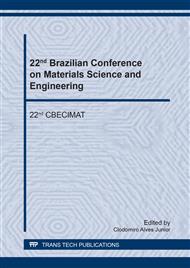[1]
O. Fischer J. Schneider: Journal of Magnetism and Magnetic Materials Vols. 254-255 (2003), p.302.
Google Scholar
[2]
E.G. Castañeda, A.S. Rodríguez: Journal of Magnetism and Magnetic Materials Vol. 323 (2011), 2524.
Google Scholar
[3]
Chaudhury et al.: Journal of Magnetism and Magnetic Materials Vol. 313 (2007), p.21.
Google Scholar
[4]
R.A. Mccurrie: Ferromagnetic Materials -Structure and Properties. (Academic Press, 1994).
Google Scholar
[5]
J. Park, J. Szpunar: Journal of Magnetism and Magnetic Materials Vol. 321 (2009), p. (1928).
Google Scholar
[6]
Wang J, et al.: Met. Mater. Int. Vol. 18(3) (2012), p.531.
Google Scholar
[7]
P. Gobernado, R. Petrov, D. Ruiz, L. Kestens: Advanced Engineering Materials Vol. 12 (10) (2010), p.1077.
Google Scholar
[8]
M. Cunha, S. Paolinelli: Materials Science Forum Vols. 467-470 (2004), p.869.
Google Scholar
[9]
M. Cunha, P. Luna: 55° Congresso Anual da Associação Brasileira de Metalurgia e Materiais (ABM). Rio de Janeiro, 24-28 de julho de 2000. Proceeding...Rio de Janeiro (2000). (RJ).
DOI: 10.22239/2317-269x.01977
Google Scholar
[10]
L. Kestens, S. Jacobs Texture Control During the Manufacturing of Nonoriented Electrical Steels. Hindawi Publishing Corporation. 2008:1-9. Article ID 173083. http://dx.doi.org/10.1155/2008/173083.
DOI: 10.1155/2008/173083
Google Scholar
[11]
R.A.C. Felix, L. Brandao, M.A. Cunha, C.H.P. Paiva, J.R.L. Amaro, L. Teles, R.L.O. Rosa, R.P.G. Júnior, T.A. Saldanha, V.H.G. Bezerra: Materials Science Forum Vols. 775-776 (2014), p.427.
DOI: 10.4028/www.scientific.net/msf.775-776.427
Google Scholar
[12]
T. Ros Yáñez, Y. Houbaert: IEEE Transactions on Magnetics Vol. 38 (5) (2002), p.3201.
Google Scholar
[13]
R.J. Roe: Journal of Applied Physics Vol. 36 (6) (1965), p.2024. http://dx.doi.org/10.1063/1.1714396.
Google Scholar
[14]
M.A. Cunha, P.C. Luna: Acta Microscopica Vol. 8 (A) (1999), p.289.
Google Scholar
[15]
K. Matsumura, B. Fukuda: IEEE Trans. Magn Vol. 20 (5) (1984), p.1533.
Google Scholar


